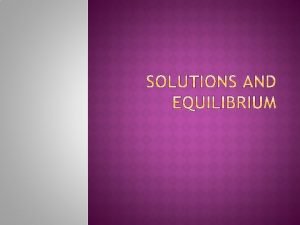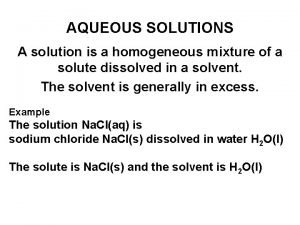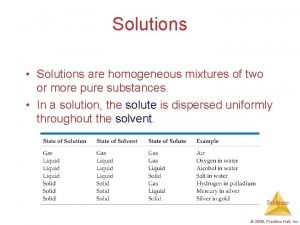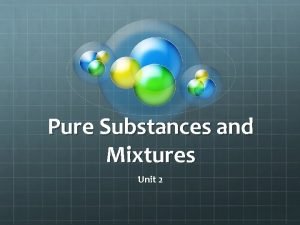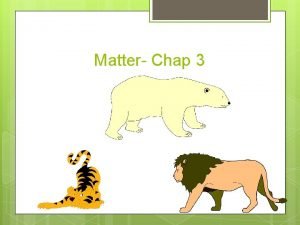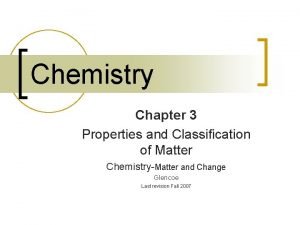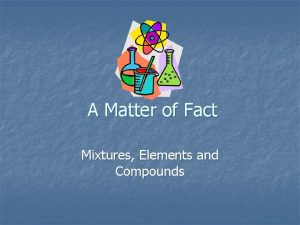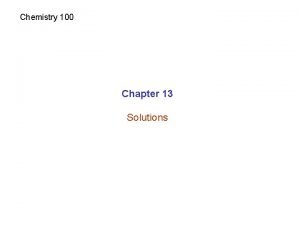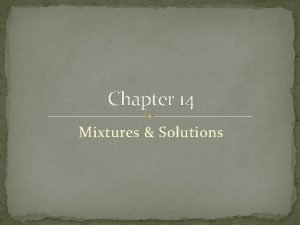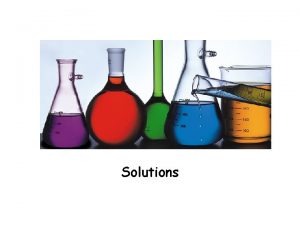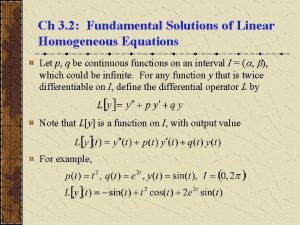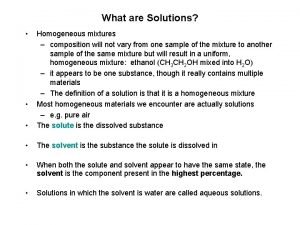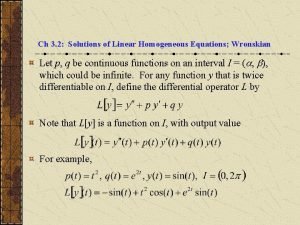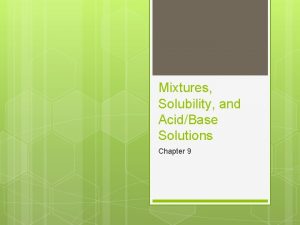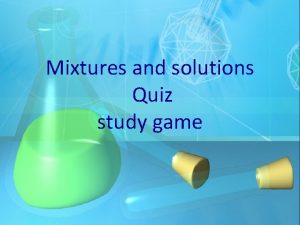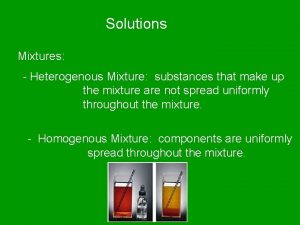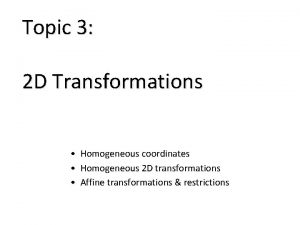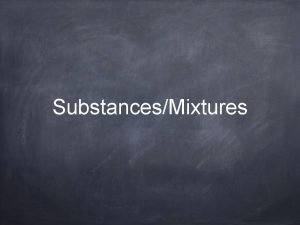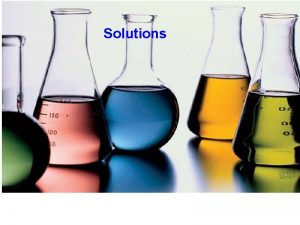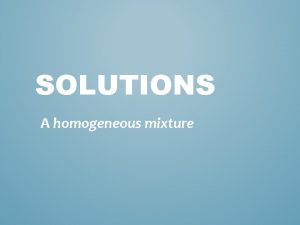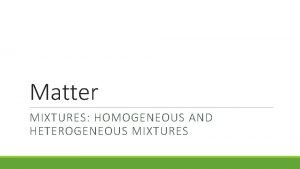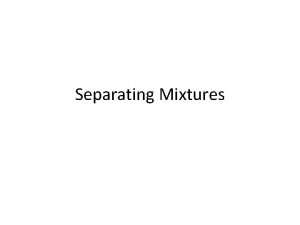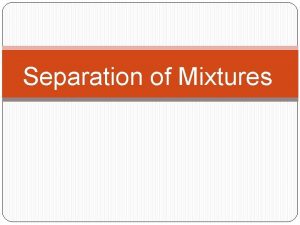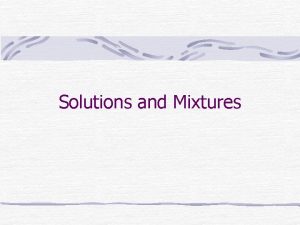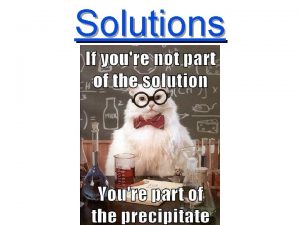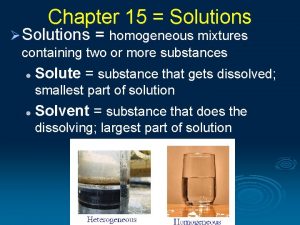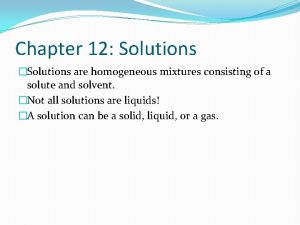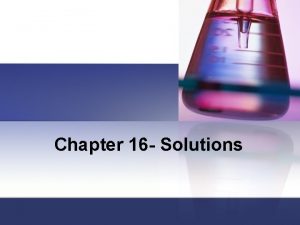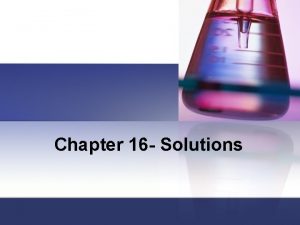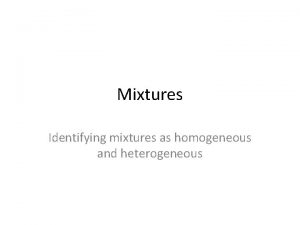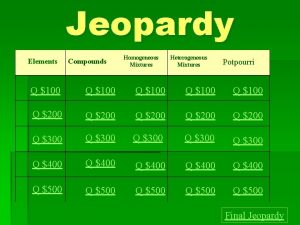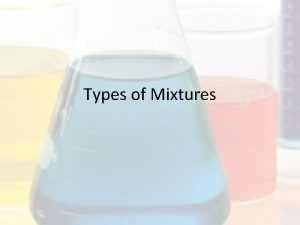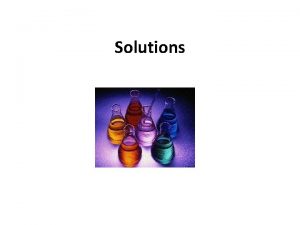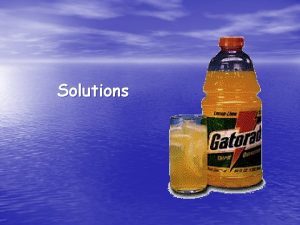Chapter 8 Solutions Solutions are homogeneous mixtures of




























- Slides: 28

Chapter 8 Solutions

Solutions are homogeneous mixtures of two or more substances; Solutions consist of a solvent and one or more solutes Solutes are spread evenly throughout the solution cannot be separated by filtration can be separated by evaporation are not visible but can give a color to the solution

In a solution, the solute is uniformly distributed throughout the solvent

Water is the most common solvent it is a polar molecule forms hydrogen bonds between the hydrogen atom in one molecule and the oxygen atom in a different water molecule

Formation of solutions Na+ and Cl– ions on the surface of a Na. Cl crystal are attracted to polar water molecules are hydrated in solution by many H 2 O molecules surrounding each ion Two substances are likely to form a solution when there is an attraction between the particles of the solute and solvent; A polar solvent (such as water) dissolves polar solutes (such as sugar) and/or ionic solutes (such as Na. Cl) A non-polar solvent such as hexane (C 6 H 14) will dissolves non-polar solutes such as oil or grease

Hydrogen bonding in water and related substances R-O-H. . O-R / H

Water and CH 2 Cl 2 a) Water (top) and methylene chloride, CH 2 Cl 2 (bottom) b) Addition of I 2 to water and methylene chloride c) Addition of green Ni. Cl 2 (nickel II chloride) to water and methylene chloride

In water, strong electrolytes produce ions and conduct an electric current weak electrolytes produce a few ions non-electrolytes do not produce ions even though the sugar dissolves The movement of charge constitutes an electric current


Solubility refers to the maximum amount of solute that dissolves in a specific amount of solvent, usually 100 g Unsaturated solutions contain less than the maximum amount of solute Effect of temperature on solubility The solubility of most solids increases as temperature increases The solubility of of gases decreases as temperature increases

The solubility of a gas in a liquid is directly related to the pressure of that gas above the liquid; at higher pressures, more gas molecules dissolve in the liquid

Not all salts are soluble in water Solubility is a relative measure: Soluble salts dissolve to the extent of 1 g /100 g water or more Sparingly soluble salts dissolve to the extent of less than 1 g/100 g of water but more than 0. 1 g/100 g water Insoluble salts dissolve to less the 0. 1 g/100 m. L of water

Ba(NO 3)2 + H 2 O = Na 2 SO 4 Ba+2 + 2 NO 3 - + H 2 O = 2 Na+ + SO 4 -2 Ba+2 + 2 NO 3 - + 2 Na+ + SO 4 -2 = Ba. SO 4 + 2 NO 3 - + 2 Na+ Results of a barium enema using X-rays Barium is very toxic but Ba. SO 4 is very insoluble Why is Ba. SO 4 used in this procedure? solubility is 1*10 -5 mol/liter or 0. 00233 g/L Ba 137 g/mol 137+32+64 =233 g/mol S 32 g/mol 233 g/mol*10 -5 mol/L O 16 g/mol

Kidney stones are either calcium phosphate, Ca 3(PO 4)2, calcium oxalate, Ca. C 2 O 4 or uric acid, C 5 H 4 N 4 O 3

Concentrations The concentration of a solution is the amount of solute dissolved in a specific amount of solution concentration = amount of solute amount of solution concentration (mass/mass (m/m)) = 8/50; = 0. 16 g KCl/g solution

Types of concentration mass/mass (m/m) mass/volume of solution (m/v) volume/volume of solution (v/v) moles/liter M Cl: 35. 5 at mass Na: 23. 0 at mass Na. Cl 58. 5 g /mol

Solutions contain small particles (ions or molecules) are transparent do not separate, even by filtration or through a semipermeable membrane do not scatter light Colloids have medium-sized particles cannot be separated by filtration can be separated by semipermeable membranes scatter light

Suspensions have very large particles settle out can be separated by filtration must be stirred to stay suspended Examples: blood platelets, muddy water, and calamine lotion

The effect of solutes on the properties of solvents Notice that the effect depends on the number of particles that form in solution ethylene glycol (antifreeze) unchanged in water: 1 mol lowers the freezing temperature 1. 86° C An equivalent amount of Na. Cl that forms Na+ and Cl- ions in water doubles the effect 1 mol of Ca. Cl 2 which forms Ca+2 and 2 Cl- triples the effect

Osmosis In osmosis, water (solvent) flows from the lower solute concentration into the higher solute concentration; the level of the solution with the higher solute concentration rises; at equilibrium, when the levels of the two solutions don’t change anymore with time, the amount of water flowing between the two sides is equal because of the greater pressure generated by the two unequal levels Osmotic pressure is the pressure generated by the two unequal levels

4% starch 10% starch A semipermeable membrane separates a 4% starch solution from a 10% starch solution. Starch cannot pass through the membrane, but water can. What happens? Osmotic pressure 7% starch

Red blood cells have cell membranes that are semipermeable they maintain an osmotic pressure that cannot change without damage occuring they must maintain an equal flow of water between the cell and its surrounding environment An isotonic solution exerts the same osmotic pressure as red blood cells 5. 0% (m/v) glucose or 0. 9% (m/v) Na. Cl is used medically because each has a solute concentration equal to the osmotic pressure equal to red blood cells

A hypotonic solution has a lower osmotic pressure than red blood cells (RBCs) containes fewer dissolved particles than blood serum causes water to flow into RBCs causes hemolysis (RBCs swell and may burst) A hypertonic solution has a higher osmotic pressure than RBCs containes more dissolved particles than blood serum causes water to flow out of RBCs causes crenation (RBCs shrink in size)

In dialysis, solvent and small solute particles pass through an artificial membrane; large particles are retained inside; waste particles such as urea from blood are removed using hemodialysis (artificial kidney)

A semipermeable membrane separates two compartments, A and B. If the levels of solutions in A and B are equal initially, select the diagram that illustrates the final levels for each of the following: A B a. 2% (m/v) starch 8% (m/v) starch b. 1% (m/v) starch c. 5% (m/v) sucrose 1% (m/v) sucrose d. 0. 1% (m/v) sucrose

Explain what happened to the coke bottle in the polycarbonate bottle

An isotonic 0. 9% (m/v) Na. Cl solution of exerts the same osmotic pressure as red blood cells What is the concentration of this solution in moles /liter (M)? 0. 9% (m/v) means there are 0. 009 g/m. L solution; How much Na. Cl would be in 1 L of solution? 0. 009 g/m. L*1000 m. L = 9 g of Na. Cl; How many moles is this? Na = 23 g/mol; Cl = 35. 5 g/mol Cl; MW = 23+35. 5; MW = 58. 5 g/mol 9 g/58. 5 g/mol = 0. 154 moles/liter of solution; The solution is 0. 154 M

Nalorphine (C 19 H 21 NO 3), a relative of morphine, is used to combat withdrawal symptoms in narcotics users. How many m. L of a 1. 0*10 -3 M solution are needed to administer a dose of 3. 11 mg? MW Nalorphine = 19*12 = 228 21*1 = 21 14*1 = 14 16*3 = 48 311 How many moles of Nalorphine are in a 3. 11 mg sample? 0. 00311 g /311 g/mol = 1*10 -5 moles 1. 0*10 -3 moles/L*V(L) = 1. 0*10 -5 moles V = 1. 0*10 -5 moles/ 1. 0*10 -3 moles/L V = 1*10 -2 L * 1000 m. L/L = 10 m. L
 Mikael ferm
Mikael ferm Are all solutions homogeneous mixtures
Are all solutions homogeneous mixtures Are all aqueous solutions homogeneous
Are all aqueous solutions homogeneous Are aqueous solutions homogeneous mixtures
Are aqueous solutions homogeneous mixtures Solutions are homogeneous mixtures
Solutions are homogeneous mixtures Homogeneous and non homogeneous differential equation
Homogeneous and non homogeneous differential equation Mixture
Mixture Heterogeneous mixture definition
Heterogeneous mixture definition Common homogeneous mixtures
Common homogeneous mixtures Facts about homogeneous mixtures
Facts about homogeneous mixtures Chapter 14 mixtures and solutions answer key
Chapter 14 mixtures and solutions answer key Chapter 13 mixtures and solutions answers
Chapter 13 mixtures and solutions answers Colloids mixture
Colloids mixture Are solutions homogeneous
Are solutions homogeneous Fundamental solutions of linear homogeneous equations
Fundamental solutions of linear homogeneous equations Gaseous solution
Gaseous solution Homogeneous mixture solution
Homogeneous mixture solution Fundamental solutions of linear homogeneous equations
Fundamental solutions of linear homogeneous equations Venn diagram compare and contrast mixtures and solutions
Venn diagram compare and contrast mixtures and solutions Mixtures solubility and acid/base solutions answer key
Mixtures solubility and acid/base solutions answer key Mixtures worksheet
Mixtures worksheet Separating mixtures simulation
Separating mixtures simulation What is mixture in science grade 7
What is mixture in science grade 7 Mixtures and solutions quiz
Mixtures and solutions quiz Term 3 natural science grade 6
Term 3 natural science grade 6 Solutions are heterogenous mixtures
Solutions are heterogenous mixtures Homogeneous coordinate
Homogeneous coordinate Is chunky peanut butter homogeneous or heterogeneous
Is chunky peanut butter homogeneous or heterogeneous Linear homogeneous recurrence relation
Linear homogeneous recurrence relation

